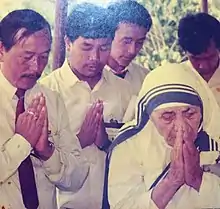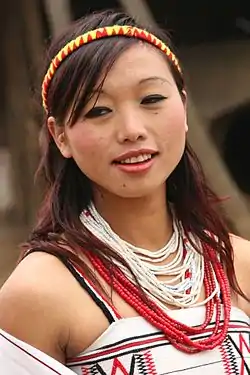Nocte people
The Nocte are an ethnic Naga tribe primarily living in Arunachal. They number about 111,679 (Census 2011), mainly found in the Patkai hills of Tirap district of Arunachal Pradesh, India. Ethnically related to the Konyak Naga, their origins can be traced back to the Hukong Valley in Myanmar, where they migrated from between the 1670 and 1700.
 Nocte traditional attire | |
| Total population | |
|---|---|
| 111,679 | |
| Regions with significant populations | |
| Tirap District, Arunachal Pradesh: 111,679 | |
| Languages | |
| Nocte, Assamese, English | |
| Religion | |
| Christianity 44%, Hinduism 23%, Animism 17% | |
| Related ethnic groups | |
| Wancho, Konyak, Naga tribes |
Their chiefs who were originally known as Ang or Raja (Raja is Vaishnavism influence) exert control over the village with his council the "Ngoang-Wang" (modern-day cabinet), and since they did not have an army under their control they would consult trusted family(lowang-tang) on an important matter. The Chief also consult village elders and priests on all important socio-religious ceremonies.
Terminology
The term Nocte was coined in the 1950s. It has been derived from two words: Nok, which means village, and Tey, which means people. In the medieval and the colonial period, the Nocte tribe was called Noga or Naga, because of the tribe's close ethnic relation with the Naga tribes of Nagaland. As per the location of the village, the Ahoms called the Noctes as Namsangya or Namsangia, Borduaria or Bor Duris, and Paniduaria. [1][2]
Religion
The last ruler of united Namsang, Borduria and Laptang, Lotha Khunbao was known for his spirituality and accepted tenets of Vaishnavism in early 18th Century. He was named as "Narottam", meaning the best among men, by Sri Ram, the Gukhai of the Bare Ghar Satra. In 1972 Lt: Governor late Col. KAA Raja honored Lotha Khunbao by naming (Namsang-mukh) as 'Narottam Nagar', where now, the reputed institution, Ramakrishna Mission School was established and funded by Namsang-Borduria Fund (from the revenue arising out of Namsang & Borduria people reserve Forest). A picture of the chief and his wife is also available in the British Archive Museum. This has brought them closer to the Hindu culture of much of the rest of India. The 1961 census reported some Buddhists among the Nocte.[3][4]
The Nocte were followers of Theravada Buddhism and Animism, although they have adopted Hinduism[5] since the 18th Century, under the influence of Sri Ram or Shankardeva.[6]
Traditionally Nocte Naga believed in Nature worship. All cosmic power was known as 'Jauban' and worshiped. Their animist religiosity was akin to the "Native American". After death, the spirit of the mighty Chief becomes 'Laa' or mighty Eagle. Other malevolent and benevolent deities are also worshipped as well. Offerings of food and water are given to the gods in order to appease them.[7]The Noctes from Namsang village were the first to come in contact with Christianity when American Baptist missionary Miles Bronson visited the village in January 1839 and lived there with his family till the second half of 1840. Bronson's primary objective was to convert the Noctes into Christianity and set up school. He and his wife succeeded in opening a school and even printed several books in Romanized Nocte. However, the missionaries failed to convert the tribe into Christianity as they refused to abandon their own religion. [8]

Christianity was successfully introduced in the late 20th Century. On August 2, 1993, Mother Teresa visited Borduria village and inaugurated the first Catholic Church of Arunachal Pradesh. It was the only place visited by her in the state. She also laid the foundation for the House for Missionaries of Charity (MC) Sisters. [9]
Of late, Baptist missionaries have converted about one-fifth to one-third of the Nocte to Christianity, principally those living in Khonsa. One Buddhist Channel in 2010 claimed there were no Christians anywhere in Arunachal Pradesh province in 1951, which seems to indicate that this conversion to Christianity largely happened in the latter half of the 20th century with continuation into the 21st century.[10]
Culture
"Chalo-Loku" (Harvesting Festival or thanks, giving festival), the Nocte Naga had 14 "loku" the most important 'loku' was "Chalo-loku'. While most "Loku" of the Nocte-Naga last between 1 and 2 days; "Chalo-loku" has to last for 3 days to complete all rituals that go with this particular festival. The festival, which lasts for three days, involves the slaughter of cattle, entertainment and the gathering of food on the first day.
The second day, known as Chamkatja is an enactment of empowering the four distinctive "Clans", the "Lotung-som Cham", 'Matey-som Cham', 'Khetey-som' Cham and 'Nook Pang-mi Cham" (the Nook Pangmi-Cham warriors will be led by the "Tang-dong Lowang". This brand of youths was furious warriors. While returning from the "Nook-Pangmi-Chaam" every member of the village must give right of way to these warriors; even by the mighty chief & his family. The warriors would be received for a powerful enactment of warrior dance by the mighty Chief in his house with the best rice beers. The first 'Cham-kat" of the young Chief will not go to his clan 'Cham' but join the "Nook-Pangmi-Cham" under the care of "Tangdong-Lowang". Last day of the festival is called "Than-lang-jaa". Before the dance 'Chin-lit' ceremonies are performed by the maternal family. As an act of blessing and to ward off evil spirit fresh single ginger neckless is garland by the female members of the maternal clan. "Woo-soak" ceremony is also performed on the last day by the chief assisted by 'tan-waa' (priest) village elders "Ngoan-Wang" and council members to understand the fortunes of the new year by reading the formation of eggs tenderly pouring the eggs yolk on a specific type of leaves called "Nyap-lin". The eggs have to be fresh and collected from the village. The first eggs would be for the Chief and his family/clan, 2nd eggs will be for selecting the next 'jhum' to be cultivated (both Namsang & Borduria has 12 jhum' properly ear-marked. They will break as many eggs is required till the best 'jhum' land is selected as shown by the formation of the fresh 'egg'. After a 'jhum' is selected the council of Wiseman will also see the prosperity of the "Sala-jaah and Thingyan-Jaah" the last egg would be for the good omen of going to the plains for trade and labor contract works. The festival is then concluded with dancing around the village singing romantic songs, the climax of the festival would be the fast rhythmic movement called the "Kepa-boong". During this dance, the chief singer will evoke the holy spirit to bless the village until the next festivity.
Food
The Nocte are agriculturalists and have good planning in their daily diet. Main crops such as rice and maize are planted, as their staple food is rice, which is often supplemented by leafy vegetables, fish and meat. A local liquor brewed from rice, tapioca, and millet proved to be popular among the Nocte, although in recent times tea is consumed as well.
Dress
The menfolk have a tendency to shave their hair in the frontal part of the head, and the back tuft of hair is tied into a chignon just above the nape. The womenfolk will keep their long auburn tresses tied into a bun kept at the back of the neck, although the widow will cut their hair short on the condition if they do not remarry. Like the Wancho, they tattoo their faces and bodies.
Owing to the humid climate, the menfolk will wear a loincloth in front with cane belts, which acts as a waistband. Bamboo slips and armlets made of ivory are worn on all four limbs as well. The womenfolk tend to wear a short cotton skirt that measures from the waist to knees, and a blouse is worn to cover the upper body. The goats' horns act as earlobes, although ornaments include metal bangles and earrings are worn.
Lifestyle
The Nocte construct houses made of silts, although the chief's houses are constructed with carved massive blocks and wooden pillars. Dormitories are provided for bachelors and unmarried women separately. According to their tradition, it is a place where the elders teach children about traditional mythology, folklore, and religion. In cases of Christian families, Christian teachings are also mixed with traditional teachings as well, which is evident among Catholic converts. The chiefs are addressed in either of the two titles: Namsang and Borduria.[11]
The dormitory of a bachelor is known as a "Poh", while a bachelorettes' one is known as a "Yanpo". However, women are not permitted to enter the boys’ dormitory, although the reverse is permitted. Dormitories are built upon wooden raised piles, usually measuring four feet above the ground. The bachelors' dormitories are decorated with human skulls taken in headhunting, which are used for containing large log drums carved out from wooden logs. The drum, known as 'thum' or 'log-drum'. However, with the advancement of Western education, it has been witnessed that these practices are in decline. Headhunting, which once proved to be popular among the Nocte, has been banned in 1940 although the last head-hunting was noted in 1991 amongst the Wancho.
Hygiene issues
The Nocte followed an age-old tradition of keeping bodies of the deceased relatives in the open, either near a river or just outside their houses. The Nocte Christians, like most Nocte, would keep their body exposed for three days, although they are kept in the house.
Inevitably, the decomposed bodies would attract bacteria, insects, and germs lying in the open that produced a terrible stench. This was the cause of the frequent outbreaks of health-threatening diseases. Owing to public health education by reformers, the burial of the deceased in proper coffins have completely supplaced this traditional rite since 2004. The Kheti village, which is not far removed from Khonsa, was the last village to give up this practice in the modern Nocte society.[12]
References
- "Genesis : Terminology". Nocte Digest.
- "History of Nocte Term : Noga". Nocte Digest.
- Nava Kishor Das (1989). Ethnic Identity, Ethnicity, and Social Stratification in North-east India. Inter-India Publications. p. 38. ISBN 81-210-0218-4.
- "Lotha Khunbao". Nocte Digest.
- India Office of the Registrar General (1972). Census of India, 1971. Manager of Publications. p. 137. ISBN 81-210-0218-4.
- Jyotirindra Nath Chowdhury (1982). Arunachal Through the Ages, from Frontier Tracts to Union Territory. Distributors, Chapala Book Stall. p. 35.
- Parul Chandra Dutta (1978). The Noctes. Directorate of Research, Govt. of Arunachal Pradesh. pp. 12, 13, 81.
- "American-Nocte Relations". Nocte Digest.
- "Arunachal Pradesh: Borduria, the only place Mother Teresa visited in Arunachal". The Northeast Today.
- Buddhist channel article against Christian misisonaries
- "Tribes of Arunachal Pradesh". Archived from the original on 14 December 2006. Retrieved 12 June 2006.
- Nocte tribesmen bury last rites
